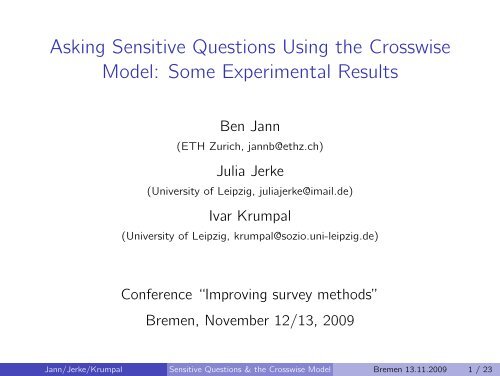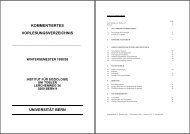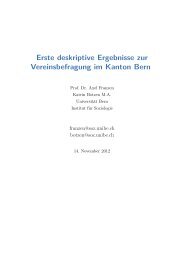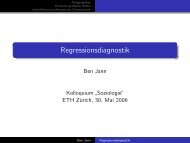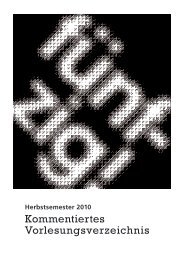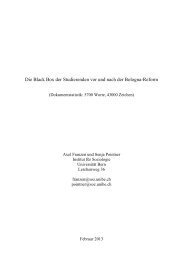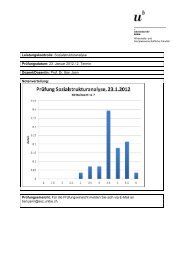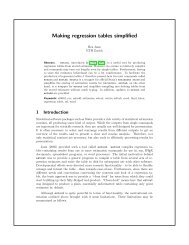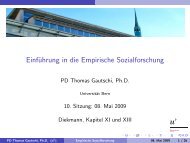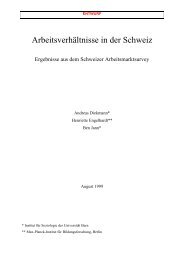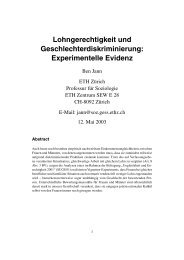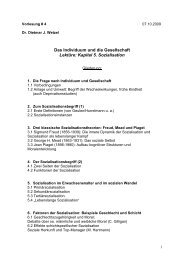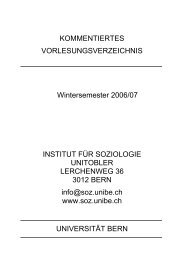Asking Sensitive Questions Using the Crosswise Model: Some ...
Asking Sensitive Questions Using the Crosswise Model: Some ...
Asking Sensitive Questions Using the Crosswise Model: Some ...
Create successful ePaper yourself
Turn your PDF publications into a flip-book with our unique Google optimized e-Paper software.
<strong>Asking</strong> <strong>Sensitive</strong> <strong>Questions</strong> <strong>Using</strong> <strong>the</strong> <strong>Crosswise</strong><br />
<strong>Model</strong>: <strong>Some</strong> Experimental Results<br />
Ben Jann<br />
(ETH Zurich, jannb@ethz.ch)<br />
Julia Jerke<br />
(University of Leipzig, juliajerke@imail.de)<br />
Ivar Krumpal<br />
(University of Leipzig, krumpal@sozio.uni-leipzig.de)<br />
Conference “Improving survey methods”<br />
Bremen, November 12/13, 2009<br />
Jann/Jerke/Krumpal <strong>Sensitive</strong> <strong>Questions</strong> & <strong>the</strong> <strong>Crosswise</strong> <strong>Model</strong> Bremen 13.11.2009 1 / 23
Outline<br />
Introduction<br />
<strong>Asking</strong> <strong>Sensitive</strong> <strong>Questions</strong><br />
Plagiarism<br />
<strong>Using</strong> Dejeopardizing Techniques to Measure Plagiarism<br />
Study A: Randomized Response Technique<br />
Study B: The <strong>Crosswise</strong> <strong>Model</strong><br />
Conclusions<br />
Jann/Jerke/Krumpal <strong>Sensitive</strong> <strong>Questions</strong> & <strong>the</strong> <strong>Crosswise</strong> <strong>Model</strong> Bremen 13.11.2009 2 / 23
<strong>Asking</strong> <strong>Sensitive</strong> <strong>Questions</strong><br />
“A question is sensitive when it asks for a socially undesirable<br />
answer, when it asks, in effect, that <strong>the</strong> respondent admits he or she<br />
has violated a social norm” (Tourangeau/Yan 2007: 860).<br />
<strong>Some</strong> respondents are unwilling to give truthful self-reports to<br />
sensitive questions. They distort <strong>the</strong>ir answers towards <strong>the</strong> social<br />
norm. This leads to social desirability bias in prevalence estimates of<br />
<strong>the</strong> sensitive behavior (e.g. systematic underestimation).<br />
Dejeopardizing question techniques such as Randomized Response<br />
(RRT, Warner 1965) were proposed to reduce social desirability bias<br />
in sensitive self-reports.<br />
We will present results for a fur<strong>the</strong>r technique called <strong>the</strong> <strong>Crosswise</strong><br />
<strong>Model</strong> (Yu et al. 2008) which, to our knowledge, has not yet been<br />
empirically evaluated.<br />
Jann/Jerke/Krumpal <strong>Sensitive</strong> <strong>Questions</strong> & <strong>the</strong> <strong>Crosswise</strong> <strong>Model</strong> Bremen 13.11.2009 3 / 23
Plagiarism<br />
What is plagiarism?<br />
Definition of <strong>the</strong> U.S. National Academy of Sciences<br />
“Appropriation of ano<strong>the</strong>r person’s ideas, processes, results, or<br />
words without giving appropriate credit, including those obtained<br />
through confidential review of o<strong>the</strong>rs’ research proposals and<br />
manuscripts”<br />
In <strong>the</strong> age of <strong>the</strong> Internet, Wikipedia, etc. Universities increasingly<br />
begin to worry about plagiarism in student papers and homework<br />
assignments.<br />
Jann/Jerke/Krumpal <strong>Sensitive</strong> <strong>Questions</strong> & <strong>the</strong> <strong>Crosswise</strong> <strong>Model</strong> Bremen 13.11.2009 4 / 23
Plagiarism<br />
Disciplinary Code<br />
of <strong>the</strong> Swiss Federal Institute of Technology Zurich<br />
(ETH Zurich Disciplinary Code)<br />
of 2 November 2004<br />
[. . . ]<br />
Art. 2 Violations of <strong>the</strong> Disciplinary Code<br />
This Disciplinary Code is applicable when a person:<br />
a. acts fraudulently in assessment tests, that is, attempts in an illicit way to gain<br />
an advantage for himself/herself or a third party;<br />
b. hands in a written assignment g that he/she has not written himself/herself, or in<br />
which he/she passes off as one's own <strong>the</strong> results and insights of ano<strong>the</strong>r<br />
(plagiarism);<br />
c. disturbs lectures or events organized by <strong>the</strong> ETH Zurich, or o<strong>the</strong>rwise disrupts<br />
<strong>the</strong> operation of <strong>the</strong> ETH Zurich;<br />
Jann/Jerke/Krumpal <strong>Sensitive</strong> <strong>Questions</strong> & <strong>the</strong> <strong>Crosswise</strong> <strong>Model</strong> Bremen 13.11.2009 5 / 23
Plagiarism<br />
Plagiarism<br />
Information Notice for Students<br />
(adapted from “Information notice on dealing with plagiarism” issued on 30 April 2007 by <strong>the</strong><br />
Teaching Committee, University of Zurich)<br />
Decreed in November 2008 by <strong>the</strong> Rector, ETH Zurich<br />
[. . . ]<br />
Disciplinary measures<br />
According to Art. 3 of <strong>the</strong> ETH Zurich Disciplinary Code, <strong>the</strong> following disciplinary measures can<br />
be imposed:<br />
� issuing a reprimand<br />
� declaring performance assessments as failed<br />
� suspending <strong>the</strong> person from courses or from using ETH facilities for a maximum of three<br />
years<br />
� threatening to suspend <strong>the</strong> person from ETH Zurich<br />
� suspending <strong>the</strong> person from ETH Zurich<br />
for a maximum of three years<br />
� divesting <strong>the</strong> person of an academic title if acquired illicitly.<br />
Jann/Jerke/Krumpal <strong>Sensitive</strong> <strong>Questions</strong> & <strong>the</strong> <strong>Crosswise</strong> <strong>Model</strong> Bremen 13.11.2009 6 / 23
Approaches to Estimate <strong>the</strong> Prevalence of Plagiarism<br />
Direct questions<br />
◮ Self-reports (past behavior; intentions)<br />
◮ O<strong>the</strong>r-reports (plagiarism of o<strong>the</strong>r students)<br />
Dejeopardizing question techniques<br />
◮ Randomized Response, Item Count Technique, etc.<br />
Data collection without asking questions<br />
◮ Official number of students found guilty<br />
◮ Systematic inspection of a sample of student papers via specialized<br />
software (e.g. TurnItIn; Plagiarism-Finder)<br />
Jann/Jerke/Krumpal <strong>Sensitive</strong> <strong>Questions</strong> & <strong>the</strong> <strong>Crosswise</strong> <strong>Model</strong> Bremen 13.11.2009 7 / 23
<strong>Some</strong> Previous Results on Plagiarism<br />
Krohn/Schlombs/Taubert (2003):<br />
◮ In <strong>the</strong> context of a course at <strong>the</strong> University of Bielefeld, Faculty of<br />
Technology, 10 out of 39 group seminar papers (N=150 students)<br />
were identified as ei<strong>the</strong>r partial or severe plagiarism.<br />
◮ Method: systematic screening of seminar papers using “Google”<br />
(Source: Krohn/Schlombs/Taubert 2003)<br />
Jann/Jerke/Krumpal <strong>Sensitive</strong> <strong>Questions</strong> & <strong>the</strong> <strong>Crosswise</strong> <strong>Model</strong> Bremen 13.11.2009 8 / 23
<strong>Some</strong> Previous Results on Plagiarism<br />
Sattler (2007):<br />
◮ In <strong>the</strong> context of a lecture at <strong>the</strong> University of Leipzig, Department of<br />
Sociology, 19.5% of <strong>the</strong> participating students (N=159) submitted<br />
seminar papers that were identified as partial plagiarism.<br />
◮ Method: systematic screening of seminar papers via <strong>the</strong> software<br />
“Plagiarism-Finder”<br />
Knoop (2006):<br />
◮ Survey of a convenience sample of students at <strong>the</strong> University of<br />
Münster, Social Sciences and History, indicates that 32.3% of <strong>the</strong><br />
respondents (N=192) know at least one plagiarizing fellow student.<br />
◮ Method: self-administered questionnaire; self- and o<strong>the</strong>r-reports<br />
◮ Problems: Weights that correct for multiple counts of a particular<br />
plagiarist were not used (see nominative technique)<br />
Jann/Jerke/Krumpal <strong>Sensitive</strong> <strong>Questions</strong> & <strong>the</strong> <strong>Crosswise</strong> <strong>Model</strong> Bremen 13.11.2009 9 / 23
<strong>Using</strong> Dejeopardizing Techniques to Measure Plagiarism<br />
We now present results from two studies in which dejeopardizing<br />
techniques were used to estimate <strong>the</strong> prevalence of plagiarism.<br />
◮ Study A: Randomized Response Technique<br />
◮ Study B: The <strong>Crosswise</strong> <strong>Model</strong><br />
Both studies were implemented as methodological experiments using<br />
direct questioning as control condition.<br />
Jann/Jerke/Krumpal <strong>Sensitive</strong> <strong>Questions</strong> & <strong>the</strong> <strong>Crosswise</strong> <strong>Model</strong> Bremen 13.11.2009 10 / 23
The Randomized Response Technique (RRT)<br />
(Warner 1965; also see, e.g., Fox and Tracy 1986)<br />
Basic idea: anonymity through randomization.<br />
Depending on <strong>the</strong> outcome of a randomization device (e.g. roll a<br />
dice), <strong>the</strong> respondent has to answer <strong>the</strong> sensitive question or give an<br />
automatic “yes” or “no” answer (or answer an unthreatening<br />
question of which <strong>the</strong> distribution is known).<br />
Since only <strong>the</strong> respondent knows <strong>the</strong> outcome of <strong>the</strong> randomization<br />
device, a “yes” answer cannot be interpreted as an admission of<br />
guilt.<br />
However, <strong>the</strong> proportion of <strong>the</strong> sample that has engaged in <strong>the</strong><br />
behavior of interest can be calculated with knowledge of <strong>the</strong><br />
properties of <strong>the</strong> randomizing device.<br />
Jann/Jerke/Krumpal <strong>Sensitive</strong> <strong>Questions</strong> & <strong>the</strong> <strong>Crosswise</strong> <strong>Model</strong> Bremen 13.11.2009 11 / 23
<strong>Using</strong> RRT to Measure Plagiarism<br />
Web-Survey among ETH students in 2005<br />
Response rate: 33 Percent<br />
Research team: Elisabeth Coutts, Andreas Diekmann, Georg<br />
Böcherer, Stefan Senn, Philipp Stadelmann, Diego Stutzer<br />
Used RRT-design:<br />
N<br />
50%<br />
50%<br />
<strong>Sensitive</strong><br />
Question<br />
50%<br />
50%<br />
?<br />
?<br />
25%<br />
25%<br />
?<br />
?<br />
beobachtete observed<br />
"Ja"-Antworten<br />
"yes"-answers<br />
25% + (0-50%)<br />
beobachtete<br />
observed<br />
"Nein"-Antworten<br />
25% "no"-answers<br />
+ (0-50%)<br />
Jann/Jerke/Krumpal <strong>Sensitive</strong> <strong>Questions</strong> & <strong>the</strong> <strong>Crosswise</strong> <strong>Model</strong> Bremen 13.11.2009 12 / 23
<strong>Using</strong> Instrument: RRT to Measure RRT Variante Plagiarism1,<br />
Bildschirm 2<br />
Jann/Jerke/Krumpal <strong>Sensitive</strong> <strong>Questions</strong> & <strong>the</strong> <strong>Crosswise</strong> <strong>Model</strong> Bremen 13.11.2009 13 / 23
<strong>Using</strong> RRT to Measure Plagiarism<br />
Results: plagiarism prevalence estimates (in percent)<br />
direct questions RRT difference<br />
seminar/term paper, 12.0 3.7 −8.3<br />
diploma <strong>the</strong>sis (2.0) (4.0) (4.4)<br />
N = 266 N = 495<br />
o<strong>the</strong>r written 19.4 17.6 −1.8<br />
assignments (1.4) (2.4) (2.8)<br />
N = 826 N = 1521<br />
(standard errors in paren<strong>the</strong>ses)<br />
Jann/Jerke/Krumpal <strong>Sensitive</strong> <strong>Questions</strong> & <strong>the</strong> <strong>Crosswise</strong> <strong>Model</strong> Bremen 13.11.2009 14 / 23
<strong>Using</strong> RRT to Measure Plagiarism<br />
Explanations for <strong>the</strong> unexpected results:<br />
◮ difficulties understanding RRT, no trust in RRT<br />
◮ Web-surveys already anonymous enough?<br />
◮ “Self-protective no” bias: Respondents who did not commit<br />
plagiarism are reluctant to give a “yes” answer to <strong>the</strong> non-sensitive<br />
question.<br />
Approaches to deal with <strong>the</strong> “self-protective no” bias<br />
◮ directly approach <strong>the</strong> problem using specific instructions<br />
◮ apply methods to detect cheaters and correct <strong>the</strong> RRT estimates<br />
◮ use alternative methods that are not (or less) affected by <strong>the</strong><br />
“self-protective no” bias<br />
Jann/Jerke/Krumpal <strong>Sensitive</strong> <strong>Questions</strong> & <strong>the</strong> <strong>Crosswise</strong> <strong>Model</strong> Bremen 13.11.2009 15 / 23
The <strong>Crosswise</strong> <strong>Model</strong><br />
(Yu, Tian, and Tang 2007)<br />
Very simply idea: Ask a sensitive question and a non-sensitive<br />
question and let <strong>the</strong> respondent indicate . . .<br />
◮ A: whe<strong>the</strong>r <strong>the</strong> answer is “yes” to both questions or “no” to both<br />
questions<br />
◮ B: whe<strong>the</strong>r <strong>the</strong> answer is “yes” to one questions and “no” to <strong>the</strong><br />
o<strong>the</strong>r<br />
non-sensitive question<br />
no yes<br />
sensitive question no A B<br />
yes B A<br />
In ei<strong>the</strong>r case, <strong>the</strong> researcher does not know whe<strong>the</strong>r <strong>the</strong> answer to<br />
<strong>the</strong> sensitive question is “yes” or “no” for a specific respondent.<br />
The prevalence of <strong>the</strong> non-sensitive item must be unequal 0.5 and<br />
known (fur<strong>the</strong>rmore, <strong>the</strong> non-sensitive item must be independent of<br />
<strong>the</strong> sensitive item).<br />
Jann/Jerke/Krumpal <strong>Sensitive</strong> <strong>Questions</strong> & <strong>the</strong> <strong>Crosswise</strong> <strong>Model</strong> Bremen 13.11.2009 16 / 23
The <strong>Crosswise</strong> <strong>Model</strong><br />
(Yu, Tian, and Tang 2007)<br />
Let<br />
◮ X be <strong>the</strong> observed answer (“A” or “B”)<br />
◮ Y be <strong>the</strong> sensitive question with πY = Pr(Y = yes)<br />
◮ Z be <strong>the</strong> non-sensitive question with πZ = Pr(Z = yes) �= 0.5<br />
◮ Cov(Y , Z) = 0<br />
Then: πA = Pr(X = A) = (1 − πY )(1 − πZ ) + πY πZ<br />
Hence: A natural estimator for πY is<br />
ˆπY = ˆπA + πZ − 1<br />
2πZ − 1<br />
Var(ˆπY ) = Var(ˆπA)<br />
(2πZ − 1) 2<br />
Note that formally <strong>the</strong> crosswise model is identical to Warner’s<br />
model.<br />
Jann/Jerke/Krumpal <strong>Sensitive</strong> <strong>Questions</strong> & <strong>the</strong> <strong>Crosswise</strong> <strong>Model</strong> Bremen 13.11.2009 17 / 23
<strong>Using</strong> <strong>the</strong> <strong>Crosswise</strong> <strong>Model</strong> to Measure Plagiarism<br />
Classroom survey (written questionnaire) at different Universities<br />
(ETH Zurich, University Leipzig, LMU Munich), Spring/Summer<br />
2009<br />
Total sample size approx. 500.<br />
3/4 crosswise model, 1/4 direct questions<br />
Research team: Ben Jann, Julia Jerke, Ivar Krumpal (thanks to<br />
Norman Braun and Jochen Groß from LMU Munich for <strong>the</strong>ir<br />
support).<br />
Jann/Jerke/Krumpal <strong>Sensitive</strong> <strong>Questions</strong> & <strong>the</strong> <strong>Crosswise</strong> <strong>Model</strong> Bremen 13.11.2009 18 / 23
Since we will not know your answers to each of <strong>the</strong> two questions, your privacy will<br />
always be protected. However, with <strong>the</strong> use of statistical methods, we can calculate<br />
Block 1 <strong>Using</strong>how <strong>the</strong> many <strong>Crosswise</strong> people answer Yes <strong>Model</strong> to <strong>the</strong> second toquestion. Measure Plagiarism<br />
1. Question: Is your mo<strong>the</strong>r’s birthday in January, February or March?<br />
Block 1<br />
2. Question: When writing an assignment (e.g. seminar paper, term paper, <strong>the</strong>sis), have<br />
1. Question: Is you your ever mo<strong>the</strong>r’s intentionally birthday adopted in January, a passage February from or someone March? else’s work without<br />
citing <strong>the</strong> original?<br />
2. Question: When writing an assignment (e.g. seminar paper, term paper, <strong>the</strong>sis), have<br />
you ever intentionally adopted a passage from someone else’s work without<br />
How are your citing answers <strong>the</strong> original? to <strong>the</strong> two questions?<br />
(A) No to both questions or Yes to both questions<br />
How are your answers to <strong>the</strong> two questions?<br />
(B) Yes to one of <strong>the</strong> two questions and No to <strong>the</strong> o<strong>the</strong>r one<br />
Block 2<br />
(A) No to both questions or Yes to both questions<br />
(B) Yes to one of <strong>the</strong> two questions and No to <strong>the</strong> o<strong>the</strong>r one<br />
1. Question: Is your fa<strong>the</strong>r’s birthday in October, November or December?<br />
Block 2<br />
2. Question: Did you ever have someone else write a large part of an assignment for you<br />
1. Question: Is or your hand fa<strong>the</strong>r’s in someone birthday else’s in October, work (e.g. November from www.hausarbeiten.de) or December? as your<br />
own?<br />
2. Question: Did you ever have someone else write a large part of an assignment for you<br />
or hand in someone else’s work (e.g. from www.hausarbeiten.de) as your<br />
How are your own? answers to <strong>the</strong> two questions?<br />
(A) No to both questions or Yes to both questions<br />
How are your answers to <strong>the</strong> two questions?<br />
(B) Yes to one of <strong>the</strong> two questions and No to <strong>the</strong> o<strong>the</strong>r one<br />
(A) No to both questions or Yes to both questions<br />
Jann/Jerke/Krumpal (B) Yes to one <strong>Sensitive</strong> of <strong>the</strong> <strong>Questions</strong> two questions & <strong>the</strong> <strong>Crosswise</strong> and No <strong>Model</strong> to <strong>the</strong> o<strong>the</strong>r Bremen one 13.11.2009 19 / 23
<strong>Using</strong> <strong>the</strong> <strong>Crosswise</strong> <strong>Model</strong> to Measure Plagiarism<br />
Results: plagiarism prevalence estimates (in percent)<br />
direct questions crosswise difference<br />
(N = 96) (N = 310)<br />
partial plagiarism 7.3 22.3 15.0<br />
(2.7) (5.5) (6.1)<br />
full plagiarism 1.0 1.6 0.6<br />
(1.0) (5.0) (5.1)<br />
(standard errors in paren<strong>the</strong>ses)<br />
Jann/Jerke/Krumpal <strong>Sensitive</strong> <strong>Questions</strong> & <strong>the</strong> <strong>Crosswise</strong> <strong>Model</strong> Bremen 13.11.2009 20 / 23
<strong>Using</strong> <strong>the</strong> <strong>Crosswise</strong> <strong>Model</strong> to Measure Plagiarism<br />
. cwlogit plagiat1 crosswise zurich munich female bachelor semester ///<br />
¿ journals internet students proofread goodgrades, pyes(pyes) nolog<br />
<strong>Crosswise</strong> model logistic regression Number of obs = 379<br />
Nonzero outcomes = 189<br />
P(surrogate ”yes”) = pyes Zero outcomes = 190<br />
LR chi2(11) = 20.83<br />
Prob ¿ chi2 = 0.0352<br />
Log likelihood = -202.9246 Pseudo R2 = 0.0488<br />
plagiat1 Coef. Std. Err. z P¿—z— [95% Conf. Interval]<br />
crosswise 1.90966 .5951165 3.21 0.001 .7432529 3.076067<br />
zurich 1.205714 .8628404 1.40 0.162 -.4854224 2.89685<br />
munich -.2935347 .9339085 -0.31 0.753 -2.123962 1.536892<br />
female .1310311 .6306861 0.21 0.835 -1.105091 1.367153<br />
bachelor .0719657 .7070102 0.10 0.919 -1.313749 1.45768<br />
semester -.1511776 .1316926 -1.15 0.251 -.4092904 .1069352<br />
journals -.0420907 .7151018 -0.06 0.953 -1.443665 1.359483<br />
internet 1.34571 2.364382 0.57 0.569 -3.288394 5.979814<br />
students 1.35031 .6117542 2.21 0.027 .1512942 2.549326<br />
proofread .0769544 .7458451 0.10 0.918 -1.384875 1.538784<br />
goodgrades -.8288506 .8247797 -1.00 0.315 -2.445389 .7876879<br />
˙cons -3.575383 2.508581 -1.43 0.154 -8.492112 1.341346<br />
Jann/Jerke/Krumpal <strong>Sensitive</strong> <strong>Questions</strong> & <strong>the</strong> <strong>Crosswise</strong> <strong>Model</strong> Bremen 13.11.2009 21 / 23
Conclusions<br />
Compared to <strong>the</strong> RRT, <strong>the</strong> <strong>Crosswise</strong> <strong>Model</strong> is easier to implement<br />
for both interviewer and respondent:<br />
◮ A randomizing device (e.g. coins, cards, dice) is not required<br />
◮ Lower complexity of interviewer instructions<br />
◮ Lower cognitive burden for <strong>the</strong> respondent<br />
Due to its lower complexity, <strong>the</strong> <strong>Crosswise</strong> <strong>Model</strong> seems better<br />
suited for application in self-administered questionnaires.<br />
Most importantly, <strong>the</strong> <strong>Crosswise</strong> <strong>Model</strong> appears to generate a higher<br />
sense of protection and is better suited to overcome <strong>the</strong><br />
“self-protective no” bias (<strong>the</strong>re is no obvious self-protective<br />
answering strategy).<br />
Jann/Jerke/Krumpal <strong>Sensitive</strong> <strong>Questions</strong> & <strong>the</strong> <strong>Crosswise</strong> <strong>Model</strong> Bremen 13.11.2009 22 / 23
References<br />
Fox, James Alan, and Paul E. Tracy. 1986. Randomized response: A method for<br />
sensitive surveys. London: Sage<br />
Knoop, S. 2006. Plagiat per Mausklick – Das Plagiieren von Internettexten in<br />
wissenschaftlichen Hausarbeiten. Eine explorative Befragung von Studierenden<br />
und Dozenten an der WWU Münster. Magisterarbeit, Universität Münster.<br />
Krohn, W., C. Schlombs, and N.-C. Taubert. 2003. Plagiierte Hausarbeiten.<br />
Problemlage an der Universität Bielefeld. In:<br />
http://www.uni-bielefeld.de/Benutzer/MitarbeiterInnen/Plagiate/iug2001.html<br />
Sattler, S. 2007. Plagiate in Hausarbeiten: Erklärungsmodelle mit Hilfe der<br />
Rational Choice Theorie. Hamburg: Verlag Dr. Kovac.<br />
Tourangeau, R., and T. Yan. 2007. <strong>Sensitive</strong> questions in surveys. Psychological<br />
Bulletin 133: 859-883.<br />
Warner, S. L. 1965. Randomized-response: A survey technique for eliminating<br />
evasive answer bias. Journal of <strong>the</strong> American Statistical Association 60:63–69.<br />
Yu, J.-W., G.-L. Tian, and M.-L. Tang. 2008. Two new models for survey<br />
sampling with sensitive characteristic: design and analysis. Metrika 67:251-263.<br />
Jann/Jerke/Krumpal <strong>Sensitive</strong> <strong>Questions</strong> & <strong>the</strong> <strong>Crosswise</strong> <strong>Model</strong> Bremen 13.11.2009 23 / 23


